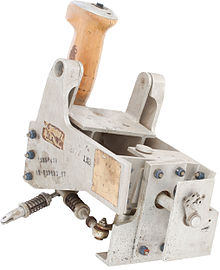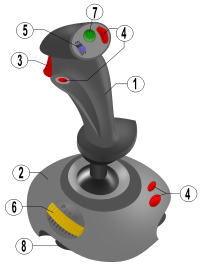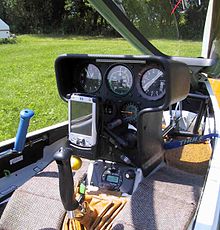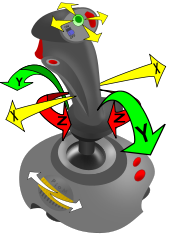- Joystick
-
For other uses, see Joystick (disambiguation).
A joystick is an input device consisting of a stick that pivots on a base and reports its angle or direction to the device it is controlling. Joysticks, also known as 'control columns', are the principal control in the cockpit of many civilian and military aircraft, either as a center stick or side-stick. They often have supplementary switches on them to control other aspects of the aircraft's flight.
Joysticks are often used to control video games, and usually have one or more push-buttons whose state can also be read by the computer. A popular variation of the joystick used on modern video game consoles is the analog stick. Joysticks are also used for controlling machines such as cranes, trucks, underwater unmanned vehicles, wheelchairs, surveillance cameras and zero turning radius lawn mowers. Miniature finger-operated joysticks have been adopted as input devices for smaller electronic equipment such as mobile phones.
Contents
Aviation
 A Project Gemini joystick-type hand controller, 1962
A Project Gemini joystick-type hand controller, 1962
Joysticks originated as controls for aircraft ailerons and elevators, and is first known to have been used as such on Louis Bleriot's Bleriot VIII aircraft of 1908, in combination with a foot-operated rudder bar for the yaw control surface on the tail.
The name "joystick" is thought to originate with early 20th century French pilot Robert Esnault-Pelterie.[1] There are also competing claims on behalf of fellow pilots Robert Loraine, James Henry Joyce and A. E. George. Loraine is credited with entering the term "joystick" in his diary in 1909 when he went to Pau to learn to fly at Bleriot's school. George was a pioneer aviator who with his colleague Jobling built and flew a biplane at Newcastle in England in 1910. He is alleged to have invented the "George Stick" which became more popularly known as the joystick. The George and Jobling aircraft control column is in the collection of the Discovery Museum in Newcastle Upon Tyne, England. Joysticks were present in early planes, though their mechanical origins are uncertain.[2] The coining of the term "joystick" may actually be credited to Loraine, as his is the earliest known usage of the term, although he most certainly did not invent the device.
Electronic joysticks
History
The first electrical 2-axis joystick was probably invented around 1944 in Germany. The device was developed for use as part of the Germans' Kehl radio control transmitter system used in certain German bomber aircraft, used to guide both the rocket-boosted anti-ship missile Henschel Hs 293, and the unpowered pioneering precision-guided munition Fritz-X, against maritime and other targets. Here, the joystick of the Kehl transmitter was used by an operator to steer the missile towards its target. This joystick had on-off switches rather than analogue sensors. Both the Hs 293 and Fritz-X used Straßburg radio receivers in them to send the Kehl's control signals to the ordnance's control surfaces.
This invention was picked up by someone in the team of scientists assembled at the Heeresversuchsanstalt in Peenemünde. Here a part of the team on the German rocket program was developing the Wasserfall missile, a variant of the V-2 rocket, the first ground-to-air missile. The Wasserfall steering equipment converted the electrical signal to radio signals and transmitted these to the missile.
In the 1960s the use of joysticks became widespread in radio-controlled model aircraft systems such as the Kwik Fly produced by Phill Kraft (1964). The now-defunct Kraft Systems firm eventually became an important OEM supplier of joysticks to the computer industry and other users. The first use of joysticks outside the radio-controlled aircraft industry may have been in the control of powered wheelchairs, such as the Permobil (1963). During this time period NASA used joysticks as control devices as part of the Apollo missions. For example, the lunar lander test models were controlled with a joystick.
In many modern airliners aircraft, for example all Airbus aircraft developed from the 1980s, the joystick has received a new lease on life for flight control in the form of a "sidestick" — a controller similar to a games joystick, but which is used to control the flight, replacing the traditional yoke. The sidestick saves weight, improves movement and visibility in the cockpit and may be safer in an accident than the traditional "control yoke".
Electronic games
Ralph H. Baer, inventor of television video games and the Magnavox Odyssey console, released in 1972, created the first video game joysticks in 1967. They were able to control the horizontal and vertical position of a spot displayed on a screen.[3] The earliest known electronic game joystick with a fire button was released by Sega as part of their 1969 arcade game Missile, a shooter simulation game that used it as part of an early dual-control scheme, where two directional buttons are used to move a motorized tank and a two-way joystick is used to shoot and steer the missile onto oncoming planes displayed on the screen; when a plane is hit, an explosion is animated on screen along with an explosion sound.[4] In 1970,[5] the game was released in North America as S.A.M.I. by Midway Games.[4]
Taito released a four-way joystick as part of their arcade racing video game Astro Race in 1973,[6] while their 1975 run and gun multi-directional shooter game Western Gun introduced dual-stick controls with one eight-way joystick for movement and the other for changing the shooting direction. In North America, it was released by Midway under the title Gun Fight.[7] In 1976, Taito released Interceptor, an early first-person combat flight simulator that involved piloting a jet fighter, using an eight-way joystick to aim with a crosshair and shoot at enemy aircraft.[8]
The Atari standard joystick, developed for the Atari 2600, released in 1977, was a digital joystick, with a single fire button, and connected via a DE-9 connector, the electrical specifications of which were for many years the de-facto standard digital joystick specification. Joysticks were commonly used as controllers in first and second generation game consoles, but they gave way to the familiar game pad with the Nintendo Entertainment System and Sega Master System during the mid-1980s, though joysticks — especially arcade-style ones — were and are popular after-market add-ons for any console.
In 1985, Sega's third-person arcade rail shooter game Space Harrier introduced a true analog flight stick, used for movement. Its analog joystick could register movement in any direction as well as measure the degree of push, which could move the player character at different speeds depending on how far the joystick is pushed in a certain direction.[9]
Since the late 1990s, analog sticks (or thumbsticks, due to their being controlled by one's thumbs) have become standard on video game consoles and have the ability to indicate the stick's displacement from its neutral position. This means that the software does not have to keep track of the position or estimate the speed at which the controls are moved. These devices usually use a magnetic flux detector to determine the position of the stick.
During the 1990s, joysticks such as the Gravis Phoenix, Microsoft SideWinder, Logitech WingMan, and Thrustmaster FCS were in demand with PC gamers. They were considered a prerequisite for flight simulators such as F-16 Fighting Falcon and LHX Attack Chopper. Joysticks became especially popular with the mainstream success of Space flight simulator games like X-Wing and Wing Commander, as well as the "Six degrees of freedom" 3D shooter Descent. However since the beginning of the 21st century, these types of games have waned in popularity and are now considered a "dead" genre, and with that gaming joysticks have been reduced to niche products.[10][11][12][13][14]
A distinct variation of an analog joystick is a positional gun, which works differently to a light gun. Instead of using light sensors, a positional gun is essentially an analog joystick mounted in a fixed location that records the position of the gun to determine where the player is aiming on the screen.[15][16] It is often used for arcade gun games, with early examples including Sega's Sea Devil in 1972,[17] Taito's Attack in 1976[18] and Cross Fire in 1977,[19] and Nintendo's Battle Shark in 1978.[20]
Arcade sticks
Main article: Arcade controllerAn arcade stick is a large-format controller for use with home consoles or computers. They use the stick-and-button configuration of some arcade cabinets, such as those with particular multi-button arrangements. For example, the six button layout of the arcade games Street Fighter II or Mortal Kombat cannot be comfortably emulated on a console joypad, so licensed home arcade sticks for these games have been manufactured for home consoles and PCs.[21]
Technical details
Most joysticks are two-dimensional, having two axes of movement (similar to a mouse), but one and three-dimensional joysticks do exist. A joystick is generally configured so that moving the stick left or right signals movement along the X axis, and moving it forward (up) or back (down) signals movement along the Y axis. In joysticks that are configured for three-dimensional movement, twisting the stick left (counter-clockwise) or right (clockwise) signals movement along the Z axis. These three axes - X Y and Z - are, in relation to an aircraft, roll, pitch, and yaw.
An analog joystick is a joystick which has continuous states, i.e. returns an angle measure of the movement in any direction in the plane or the space (usually using potentiometers) and a digital joystick gives only on/off signals for four different directions, and mechanically possible combinations (such as up-right, down-left, etc.). (Digital joysticks were very common as game controllers for the video game consoles, arcade machines, and home computers of the 1980s.)
Additionally joysticks often have one or more fire buttons, used to trigger some kind of action. These are simple on/off switches.
Some joysticks have haptic feedback capability. These are thus active devices, not just input devices. The computer can return a signal to the joystick that causes it to resist the movement with a returning force or make the joystick vibrate.
Most I/O interface cards for PCs have a joystick (game control) port. Modern joysticks mostly use a USB interface for connection to the PC.
Hat switch
A hat switch is a control on some joysticks. It is also known as a POV (point of view) switch. It allows one to look around in their virtual world, browse menus etc. For example, many flight simulators use it to switch the player's views,[22] while other games sometimes use it as a substitute for the D-pad; while computer gamepads modelled after PlayStation DualShock controllers assign POV switch scancodes to the D-pad of it.
The term hat switch is a sanitization of the term "Coolie Hat", named for the similar-looking headgear, which may be considered offensive.
In a real aircraft, the hat switch may control things like aileron or rudder trim.
Industrial applications
In recent times, the employment of joysticks has become commonplace in many industrial and manufacturing applications, such as; cranes, assembly lines, forestry equipment, mining trucks, and excavators. In fact, the use of such joysticks is in such high demand, that it has virtually replaced the traditional mechanical control lever in nearly all modern hydraulic control systems. Additionally, most Unmanned Aerial Vehicles (UAVs) and submersible Remotely Operated Vehicles (ROVs) require at least one joystick to control either the vehicle, the on-board cameras, sensors and manipulators.
Due to the highly hands-on, rough nature of such applications, the industrial joystick tends to be more robust than the typical video-game controller, and able to function over a high cycle life. This led to the development and employment of Hall Effect sensing to such applications in the 1980s as a means of contactless sensing. Several companies produce joysticks for industrial applications using hall effect technology. Another technology used in joystick design is the use of strain gauges to build force transducers from which the output is proportional to the force applied rather than physical deflection. Miniature force transducers are used as additional controls on joysticks for menu selection functions.
Global manufacturers that serve the largest OEM's, like Caterpillar, John Deere, AGCO, CNH, JLG, GENIE and others, are DeltaTech Controls and Penny and Giles Controls. Penny and Giles Controls also designs and manufactures joysticks for Sauer Danfoss. Apem Apem is another such manufacturer for the global market incorporating such brands are CH Products [1], Oliver Control Systems [2] and Apem own [3].
In North America, there are several small regional manufactures that also service the industry; CTI Electronics, OEM Controls, Otto Engineering, PQ Controls, CH Products, BG Systems, and Elobau Sensor Technologies [4].
In Europe, there are several manufacturers that supply specialized market sectors, such as crane controls, aviation, etc.. One of the European global joystick suppliers is the Swiss company Genge & Thoma AG, supplying standard and tailor made industrial grade joysticks. In the UK Printed Motor Works have recently taken over the production of the Flightlink Controls/PML Flightlink ranges of industrial
Some larger manufactures of joysticks are able to customize joystick handles and grips specific to the OEM needs while small regional manufacture often concentrate on selling standard products at higher prices to smaller OEM's.
Assistive technology
Specialist joysticks, classed as an assistive technology pointing device, are used to replace the computer mouse for people with fairly severe physical disabilities. Rather than controlling games these joysticks plug into the USB port and control the mouse pointer. They are often useful to people with athetoid conditions, such as cerebral palsy, who find them easier to grasp than a standard mouse. Miniature joysticks are also available for people with conditions involving muscular weakness such as muscular dystrophy or motor neuron disease. They are also used on electric powered wheelchairs for control since they are simple and effective to use as a control method.
See also
- Aircraft flight control system
- Flight simulator
- Game controller
- Gamepad
- Gravis PC GamePad
- Kempston joystick
- TAC-2
- The Arcade (joystick)
References
- ^ Zeller Jr., Tom (2005-06-05). "A Great Idea That's All in the Wrist". New York Times. http://www.nytimes.com/2005/06/05/weekinreview/05zeller.html?ex=1275624000&en=127d9054b0921b1d. Retrieved 2006-09-07.
- ^ Quinion, Michael (2004-07-17). "Questions & Answers: Joystick". World Wide Words. http://www.worldwidewords.org/qa/qa-joy1.htm. Retrieved 2006-09-07.
- ^ Edwards, Benj (2004-07-17). "Video Games Turn Forty". 1UP.com. http://www.1up.com/do/feature?pager.offset=2&cId=3159462. Retrieved 2008-05-13.
- ^ a b Missile at the Killer List of Videogames
- ^ S.A.M.I. at the Killer List of Videogames
- ^ Astro Race at the Killer List of Videogames
- ^ Stephen Totilo, In Search Of The First Video Game Gun, Kotaku
- ^ Interceptor at the Killer List of Videogames
- ^ Space Harrier Retrospective, IGN
- ^ Peckham, Matt (September 26, 2006). "DarkStar One". SciFi.com. http://www.scifi.com/sfw/games/sfw13762.html. Retrieved 2007-11-17.[dead link]
- ^ "Space Interceptor: Project Freedom". MyGamer. November 9, 2004. http://www.mygamer.com/index.php?id=550484&page=gameportal&mode=reviews. Retrieved 2007-11-17.
- ^ Weise, Matt (May 28, 2003). "Freelancer". GameCritics. http://www.gamecritics.com/review/freelancer/main.php. Retrieved 2007-11-17.
- ^ LaMosca, Adam (July 18, 2006). "Lost in the Void". The Escapist. http://www.escapistmagazine.com/articles/view/issues/issue_54/324-Lost-in-the-Void. Retrieved 2007-11-17.
- ^ Wen, Howard (February 12, 2008). "What Happened To The Last Starfighters?". The Escapist. http://www.escapistmagazine.com/articles/view/issues/issue_136/2918-What-Happened-To-The-Last-Starfighters. Retrieved 2008-06-20.
- ^ Morgan McGuire & Odest Chadwicke Jenkins (2009), Creating Games: Mechanics, Content, and Technology, A K Peters, Ltd., p. 408, ISBN 1568813058, http://books.google.co.uk/books?id=0G3PKwgvizEC, retrieved 2011-04-03, "Light guns, such as the NES Zapper or those used in the House of the Dead series, are distinctly different from positional guns used by arcade games such as SEGA's Gunblade NY. ... Light guns differ from positional guns, such as in Gunblade NY (bottom), that are essentially analog joysticks. ... Positional guns are essentially analog sticks mounted in a fixed location with respect to the screen. Light guns, in contrast, have no fixed a priori relationship with a display."
- ^ Yo-Sung Ho & Hyoung Joong Kim (November 13-16, 2005), Advances in Multimedia Information Processing-PCM 2005: 6th Pacific-Rim Conference on Multimedia, Jeju Island, Korea, Springer Science & Business, p. 688, ISBN 3540300406, http://books.google.co.uk/books?id=z-KQDQ0BtG4C&pg=PA688, retrieved 2011-04-03, "The two routes to conventional gun control are light guns and positional guns. Light guns are the most common for video game systems of any type. They work optically with screen and do not keep track of location on the screen until the gun is fired. When the gun is fired, the screen blanks for a moment, and the optics in the gun register where on the screen the gun is aimed. That information is sent to the computer, which registers the shot. ... Positional guns are mounted stationary on the arcade cabinet with the ability to aim left/right and up/down. They function much like joysticks, which maintain a known location on screen at all times and register the current location when fired."
- ^ Sea Devil at the Killer List of Videogames
- ^ Attack at the Killer List of Videogames
- ^ Cross Fire at the Killer List of Videogames
- ^ Battle Shark at the Killer List of Videogames
- ^ Gerry Block (December 18, 2007). "Arcade in a Box Xbox 360 Arcade Stick". IGN. http://uk.gear.ign.com/articles/842/842386p1.html. Retrieved 2009-04-21.
- ^ "Microsoft Combat Flight Simulator 2, EU-Inside Moves Series, Jeff Van West, Book - Barnes & Noble". Search.barnesandnoble.com. http://search.barnesandnoble.com/booksearch/isbninquiry.asp?z=y&ean=9780735611764&displayonly=EXC. Retrieved 2010-08-18.
External links
- AtomicWarrior - Joysticks on Windows
- Whatever happened to the joystick?
- Help page for connecting old joysticks to new computers
- The largest Vintage Digital Joystick Museum in the world
This article was originally based on material from the Free On-line Dictionary of Computing, which is licensed under the GFDL.
Basic computer components Input devices Keyboard · Image scanner · Microphone · Pointing device (Graphics tablet · Joystick · Light pen · Mouse · Touchpad · Touchscreen · Trackball) · Webcam (Softcam)Output devices Removable data storage Computer case Central processing unit (CPU) · Hard disk / Solid-state drive · Motherboard · Network interface controller · Power supply · Random-access memory (RAM) · Sound card · Video cardData ports Ethernet · Firewire (IEEE 1394) · Parallel port · Serial port · Thunderbolt · Universal Serial Bus (USB)Categories:- Joysticks
- Aircraft controls
- Computing input devices
- Game controllers
Wikimedia Foundation. 2010.





